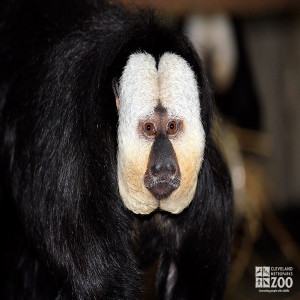Monkey, White-Faced Saki
[Pithecia pithecia]

In the pale headed saki the head and body length are 12 to 28 inches and the tail length is 10.2 to 21.8 inches. The weight is 2.4 to 5.75 pounds. The male is uniformly black with a white crown, face and throat. The female is predominately blackish or brownish. Sakis are essentially diurnal and arboreal, descending only occasionally to lower branches or shrubs in their search for food. They seldom descend to the ground or climb to the treetops because their major predators (small cats, large snakes and avian raptors) inhabit these niches. While usually moving on all fours, they are capable of making long leaps through trees, and have been observed running in an erect posture along horizontal branches. Pale-headed sakis sleep curled on a branch like a cat, and sometimes hang by their hind feet when feeding. Sakis are monogamous.
Location: Primate & Cat
Share:
Range
The range of the Pale Headed Saki is southern & eastern Venezuela, the Guianas, and northeastern Brazil.
Habitat
Pale Headed Sakis inhabit forest areas at elevations of 700 to 2,500 feet.
Conservation Status
Least ConcernPrimary Threats
Human-Wildlife ConflictGestation
Gestation for pale headed sakis takes about 150 days.
Litter
1
Behavior
Pale headed sakis are essentially diurnal and arboreal, descending only occasionally to lower branches or shrubs in their search for food. They seldom descend to the ground or climb to the treetops because their major predators (small cats, large snakes and avian raptors) inhabit these niches. They descend vertical supports tail-first. While usually moving on all fours, they are capable of making long leaps through trees, and have been observed running in an erect posture along horizontal branches. When moving bipedally they hold up their arms with fingers extended for balance. When alarmed they can move quite rapidly. When eating mammals and birds, they tear apart their prey with their hands. They have been observed going into tree hollows to collect bats, which are torn apart and skinned before being consumed. Pale-headed sakis sleep curled on a branch like a cat, and sometimes hang by their hind feet when feeding. They travel either in family groups or alone. While usually quiet in captivity, they emit loud, penetrating calls in the wild.
Reproduction
Sakis are monogamous. Birth usually takes place in late November and December. The estrous cycle lasts about 18 days.
Wild Diet
Berries, fruit, honey, leaves, flowers, small mammals
Zoo Diet
New World monkey chow, fruit, carrots, yams, lettuce, endive, primate diet, mealworms
